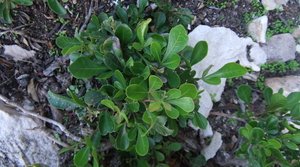Blinktaaibos as
Shrub to 3 m tall
Other observations of Glossy Currantrhus (Searsia lucida forma lucida)
Species with which Glossy Currantrhus (Searsia lucida forma lucida) interacts
Comments
Searsia!!!!
You are right to be confused. Us oldies are used to the old name and will take a while to realize that it has changed.
Sorry: have removed my agreement and posted the correction: Thanks!
But it wont be a "likely ID" until the other oldies do the same!
Forma
Thanks. (Refreshing to be right about something, even if it's only being confused!)
Now, how can one be sure about which forma it is? And, what provides sufficient reason for different formas (formae?) to be identified and named? For example, why is the dwarf form of P. nitida not separately recognised as a forma (or is it)?
sufficient reason:
The answer to this is simple. Some taxonomists have seen the need to divide their species into subspecific groups, whereas others have not.
The latter fall into two groups: those who are lazy and those whose groups are so complicated that so many subspecies, varieties and forms would be needed that it would be meaningless or impossible to do so.
Alas, there appear to be too many lazy taxonomists.
And Alas, Alas, Alas, every now and then someone tackles one of the impossible groups resulting in an impossible mess.
talking to meself again: Marlandza will be mortified ...
The King Protea is a good example.
John Rourke has acknowledged that there should be at least 3 groupings (based on Marie's work below, he does not say more than "local races" (races being a taxonomic category when one is uncertain if it should be a subspecies or variety)). But he has not formally published them, so they dont exist. This despite the fact that earlier taxonomists had recognized vars albiflora, elliptica, eriolepis, glabrata and obtusifolia, and forms cyclophylla (some of these have been published as full species). He was employed by the Botanical Institute and reviewed the genus, and only recognized two subspecies in the genus, both published by others.
Marie Vogts recognized 81 varieties of King Protea - she was funded by the horticultural trade and evaluated the populations for flowering times, colour forms, growth forms, leaf size and shape, bract shape and structure, and flowerhead shape. She grouped these varients into 3 broad groups based on leaf characters:
* oval to round-leaf: western CFR
* broad-elliptic leaf: Outeniqua to van Stadens
* small-elliptic leaf: low altitudes from George to PE.
Shrewd tacticians
Phew, I am beginning to see why some taxonomists might be inclined to a little indolence... This cat is never going to be able to look at a King again and think she knows what it is.
Going back to the Waboom (curiosity hasn't killed me yet), is the dwarf still considered to be plain ol' P. nitida?
The dwarf form does not exist ...
No its is not the same as plain old nitida: read http://za.ispot.org.uk/node/143939 to see how it differs.
But formally (as per taxonomy) it does not exist as a separate entity.
Searsia lucida forma lucida
And Alas**infinity - the only way to find out about the subspecies, varieties and forms in our current literature is to go to the primary literature.
I have had an intern help out with this and will start compiling a Subflora Cape Plants later this year.
If I can find the time ...
Subflora Cape lants.
Would be wonderful. It would do away with some of the guesswork. Some of the "oldies" had already agreed to Searsia.
Outramps CREW Group
Subflora Cape Plants
Just in case someone thinks I've lost it
Outramps CREW Group
The Searsia article
Does anybody have a PDF of the paper below that they would email to me at [email protected], please?
MOFFETT, R.O. 2007. Name changes in the Old World Rhus and recognition of Searsia (Anacardiaceae). Bothalia 37(2): 165–176.
I think this must be the paper where the whole current Searsia business started.
-- Beetledude








Rhus / Searsia ?
I'm confused: I posted (what I think is) one of these recently, reluctantly assigning an ID of Searsia. Will always think of them as Rhus, I suspect, but which is correct?